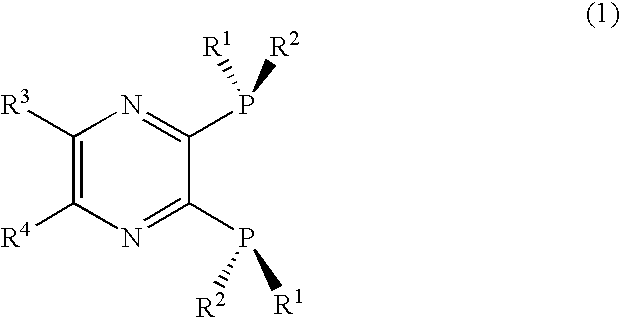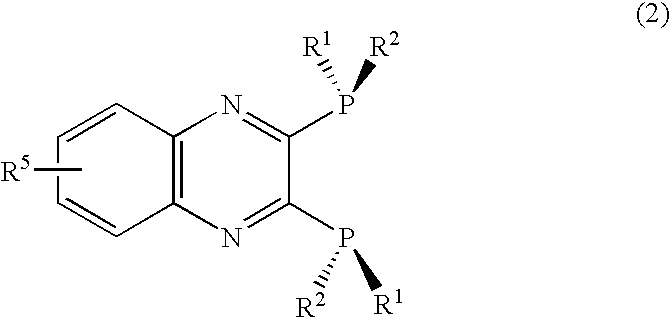2, 3-Bis(dialkylphosphino)pyrazine derivative, process of producing the same, and metal complex having the same as ligand
a technology of phosphine ligand and pyrazine, which is applied in the direction of group 5/15 element organic compounds, cadmium organic compounds, and 3/13 element organic compounds. it can solve the problems of insufficient storage stability of phosphine ligands in air and need care in handling
- Summary
- Abstract
- Description
- Claims
- Application Information
AI Technical Summary
Benefits of technology
Problems solved by technology
Method used
Image
Examples
example 1
(a) Synthesis of Compound of Formula (4)
[0038] (R)-Tert-butylmethylphosphine-borane (9), a compound represented by formula (4), was synthesized in accordance with the following reaction scheme.
[0039] In 10 ml of pyridine was dissolved 2.22 g (15.00 mmol) of (R)-tert-butyl (hydroxymethyl)methylphosphine-borane (7) (92% ee), and 2.1 ml (18 mmol) of benzoyl chloride was added thereto dropwise at 0° C. while stirring. The reaction mixture was heated up to room temperature. One hour later, the reaction mixture was diluted with water and extracted three times with ethyl ether. The organic layer was washed successively with 1 M hydrochloric acid, a sodium hydrogencarbonate aqueous solution, and a saturated sodium chloride aqueous solution and dehydrated over sodium sulfate. The solvent was removed, and the residue was purified by silica gel column chromatography (mobile phase: hexane / ethyl acetate=3 / 1). The resulting colorless solid was recrystallized twice from a hexane and ethyl acet...
example 2
Asymmetric Hydrogenation Using Rhodium Complex
[0043] Each of the substrates shown in Table 1 below (0.5 mmol) was put into a 50 ml stainless steel reaction tube connected to a hydrogen gas tank. The reaction tube was filled with 1 atm hydrogen (99.9999%, available from Nippon Sanso Corp.). Separately, 1.9 mg (5.0 μmol) of [Rh(nbd)2]BF4 and 2.0 mg (6.0 μmol) of (R,R)-2,3-bis(tert-butylmethylphosphino)quinoxaline (12) were added to 1 ml of degassed methanol, and the mixture was added to the reaction tube with a syringe. The hydrogen gas pressure in the reaction tube was increased to 3 atm. The reaction mixture was evaporated, and the residue was purified by silica gel flash chromatography using ethyl acetate as an eluent. The absolute configuration and the optical purity in terms of percent enantiomer excess (ee) of the resulting product were determined from the retention time in comparison with the standards.
TABLE 1R1R2R3ee (%)(configuration)CO2MePhH99.9 (R)CO2Me4-AcO-3-MeOC6H3H99...
example 3
1,4-Addition Reaction of Organic Boronic Acid to β,β-Unsaturated Carbonyl Compound using Rhodium Catalyst
[0044] To 1 ml of dioxane were added 1.8 mg (9.0 μmol) of [RhCl(C2H4)2]2 and 3.3 mg (9.9 μmol) of (R,R)-2,3-bis(tert-butylmethylphosphino)quinoxaline (12), and the mixture was stirred at room temperature in a nitrogen atmosphere for 15 minutes. To the reaction mixture was added 0.1 ml of a 1.5 M potassium hydroxide aqueous solution, followed by stirring for 15 minutes. To the mixture were added 0.60 mmol of the organic boronic acid shown in Table 2 below and 0.30 mmol of the β,β-unsaturated carbonyl compound shown in Table 2. After the mixture was stirred at 40° C. for 1 hour, a saturated aqueous solution of sodium hydrogencarbonate was added to stop the reaction. The reaction mixture was extracted five times with ethyl ether, and the organic layer was dried over sodium sulfate and concentrated under reduced pressure. The residue was purified by silica gel thin layer chromatogra...
PUM
| Property | Measurement | Unit |
|---|---|---|
| temperature | aaaaa | aaaaa |
| pressure | aaaaa | aaaaa |
| optically active | aaaaa | aaaaa |
Abstract
Description
Claims
Application Information
 Login to View More
Login to View More - R&D
- Intellectual Property
- Life Sciences
- Materials
- Tech Scout
- Unparalleled Data Quality
- Higher Quality Content
- 60% Fewer Hallucinations
Browse by: Latest US Patents, China's latest patents, Technical Efficacy Thesaurus, Application Domain, Technology Topic, Popular Technical Reports.
© 2025 PatSnap. All rights reserved.Legal|Privacy policy|Modern Slavery Act Transparency Statement|Sitemap|About US| Contact US: help@patsnap.com



